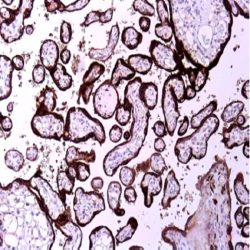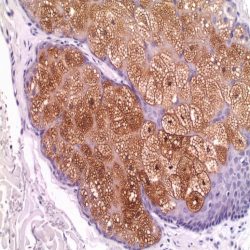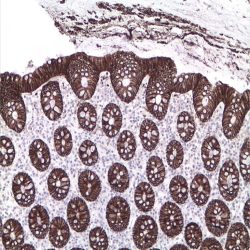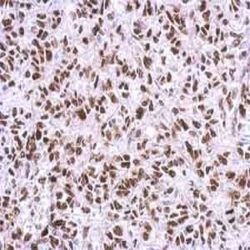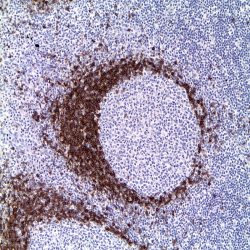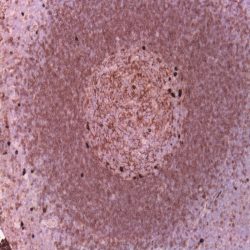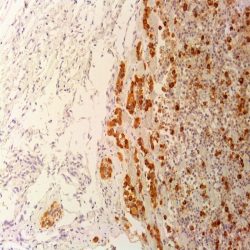Category: polyclonal
Showing 1–20 of 511 results
فیلتر ها-
آنتی بادیهای ایمونوهیستوشیمی
آنتی بادی C4d (Polyclonal)
Rated 0 out of 5Name: Rabbit anti-human C4d Polyclonal Antibody
Description and applications: This antibody recognizes the C4d fraction of complement. C4d fraction of complement represents the alpha-2 (42 kDa) portion of the C4 fraction of complemnto. Among the different complement proteins, the opsonins C3 and C4 have a protector thioester radical. This molecule allows the C4 (and C3) complement fraction to form covalent bonds when activated with the target molecule, thereby generating the C4b (C3b) molecule. When the proteolytic cleavage of C4b occurs, C4d fragment remains covalently attached to the target structure, while the C4c fragment is free.
Consecutively, C4d is a stable split product remnant of classical complement activation and an established marker of antibody-mediated acute renal allograft rejection. Due to its proclivity for endothelium, this component can be detected in peritubular capillaries in both chronic renal allograft rejection as well as hyperacute rejection, acute vascular rejection, acute cellular rejection, and borderline rejection. It has been shown to be a significant predictor of transplantkidney graft survival and is an aid in treating acute rejection.Composition: anti-human C4d rabbit polyclonal antibody purified from ascites. Prepared in 10mM PBS, pH 7.4, with 0.2% BSA and 0.09% sodium azide
Intended use: Immunohistochemistry (IHC) on paraffin embedded tissues. Not tested on frozen tissues or Western-Blotting
-
آنتی بادیهای ایمونوهیستوشیمی
آنتی بادی Carcinoembryonic Antigen (CEAp) (Polyclonal)
Rated 0 out of 5Name: Carcino embryonic Antigen (CEAp) Antibody Polyclonal
Description and applications:This antibody has a high affinity for CEA and shows no detectable reactivity to nonspecific cross-reacting antigen (NCA), biliary glycoprotein (BGP) and human polymorphonuclear leucocytes. Ab-3 shows no reaction with a variety of normal tissues .CEA is not found in benign glands, stroma, or malignant prostatic cells. Antibody to CEA is useful in detecting early foci of gastric carcinoma and in distinguishing pulmonary adenocarcinomas (60-70% are CEA+) from pleural mesotheliomas (rarely or weakly CEA+).
Composition: anti-human CEA rabbit polyclonal antibody purified from serum and prepared in 10mM PBS, pH 7.4, with 0.2% BSA and 0.09% sodium azide.
Immunogen: Human CEA isolated from hepatic metastasis of colon adenocarcinoma.
-
آنتی بادیهای ایمونوهیستوشیمی
آنتی بادیCaspase 3-کلونPolyclonal
Rated 0 out of 5Name: Caspase 3 Polyclonal Antibody
Description and aplications: Caspase 3 is ubiquitously expressed and like other caspases is synthesized as an inactive (32kDa) proenzyme. Upon activation, Caspase 3 is cleaved at Asp28-Ser29 and Asp175-Ser176 thereby generating two subunits of 17kDa and 12kDa, respectively. Recent studies have implicated that Caspase 3 is associated with the induction of apoptosis. Activation of Caspase 3 occurs in response to variety of apoptotic inducers including Fas mediated apoptosis. This antibody detects both active and inactive forms of Caspase-3 protein. The antibody is useful for studying the phenomenon of cell death by apoptosis as a pathogenic mechanism of numerous pathologies: nerve damage, neurodegenerative diseases, cardiovascular diseases, autoimmune diseases, AIDS and malignancies.
Composition: anti-human Caspase 3 rabbit polyclonal antibody purified from rabbit anti-serum by Protein A chromatography. Prepared in 10mM PBS, pH 7.4, with 0.2% BSA and 0.09% sodium azide
Immunogen: Recombinant full length human.
-
آنتی بادیهای ایمونوهیستوشیمی
آنتی بادی BOB-1 (SP92)
Rated 0 out of 5Name: BOB-1 (SP92)
Description and applications: The BOB.1, OBF.1, OCA-B (now called BOB.1 / OBF.1) is a 35 kD protein encoded by a gene located on chromosome 11q23.1. BOB.1 from “B cell binding Octamer protein 1 “is a specific coactivator of transcription factors Oct-1 and Oct-2 of B lymphocytes. BOB.1 mission is to increase transcriptional activity of such proteins. Interaction with transcription factor OCT2 octamer ATGCAAAT nucleotides is critical and decisive for the expression of immunoglobulin genes. It has been recently demonstrated that alteration in immunoglobulin transcription is correlated with the downregulation of the transcription factors Oct-2 and BOB.1 / OBF.1 on B lymphocytes. This antibody recognizes BOB.1 of human, murine and rat origin. In normal lymphoid tissue, BOB.1 is expressed mainly in the nuclei of germinal center B lymphocytes, with lower intensity in the follicular mantle and dispersed form in B lymphocytes localized in the interfolicular areas of the lymphoid tissue; for this reason it is useful in identifying B cell lymphomas. Variable intensity has been demonstrated in Hodgkin disease, classic type without statistical relationship with its different subtypes. The expression of specific activator proteins of B lymphocytes like “octamer-binding transcription factor 2” [Oct-2] and BOB.1 with pan-B lymphocyte markers (CD20 or CD79a ) are useful for the differential diagnosis of diffuse large B-cell lymphoma, nodular lymphocyte-predominant Hodgkin lymphoma (OCT-2 + / BOB.1 + / PAN-B +) with anaplastic lymphoma B (OCT-2 / BOB. 1- / PAN-B +). The antibody shows no cross-react with Oct-1 or Oct-2.
Composition: anti-human BOB-1 rabbit monoclonal antibody purified from serum and prepared in 10mM PBS, pH 7.4, with 0.2% BSA and 0.09% sodium azide
Intended use: Immunohistochemistry (IHC) on paraffin embedded tissues. Not tested on frozen tissues or Western-Blotting
-
آنتی بادیهای ایمونوهیستوشیمی
آنتی بادی FACTOR VIII (Polyclonal)
Rated 0 out of 5Name: Factor VIII Polyclonal Antibody
Description and applications: Factor VIII related antigen or von Willebrand factor is a multimeric glycoprotein, which binds to platelet glycoprotein Ib, glycoprotein IIb/IIIa, collagen and heparin. It is synthesized by endothelial cells and stored in the Weibel-Palade granules. It mediates platelet adhesion to injured vessel walls and serves as a carrier and stabilizer for coagulation factor VIII. von Willebrand factor is one of the most useful markers to identify endothelial (or megakaryocytic) lineage of neoplasms. As not all endothelial cells synthesize / store) this molecule, about 30% of tumors of vascular origin fail to stain for factor VIII related antigen, regardless of whether they are benign or malignant. Staining for factor VIII related antigen has also been used to measure angiogenesis, an indicator of tumor recurrence. This antibody has helped to establish the endothelial nature of some lesions of disputed histogenesis, e.g. Kaposi’s sarcoma and cardiac myxoma.
Composition: anti-human Factor VIII (FVIII) rabbit polyclonal antibody purified from ascites. Prepared in 10mM PBS, pH 7.4, with 0.2% BSA and 0.09% sodium azide.
-
آنتی بادیهای ایمونوهیستوشیمی
آنتی بادی Hepatitis B Virus Surface Antigen (A10F1)
Rated 0 out of 5Name: Hepatitis B Virus Core Antigen (HBVcAg) Polyclonal Antibody
Description and applications: Hepatitis B virus is spherical in shape with a diameter of 42 nm. It contains a 27 nm partially double stranded DNA core enclosed within a lipoprotein coat. The antigenic activity of the nucleocapsid core is designated as hepatitis B core antigen. The antigens in the outer surface are called as hepatitis B virus surface antigens. Core antigens are localized within the nuclei whereas the surface antigens are present in the cytoplasm of the infected cells. Antibodies to surface antigens appear in circulation at an early stage of infection whereas the antibodies to the core antigens are detected after several weeks. This antibody recognizes a protein in the core of hepatitis B virus.
Composition: anti-human HBVcAg rabbit polyclonal antibody fraction from rabbit anti-serum. Prepared in 10mM PBS, pH 7.4, with 0.2% BSA and 0.09% sodium azide.
Immunogen: Hepatitis B virus.
-
آنتی بادیهای ایمونوهیستوشیمی
آنتی بادی Helicobacter Pylori (Polyclonal)
Rated 0 out of 5Name: Helicobacter Pylori Polyclonal Antibody
Description and applications: This antibody detects the Campylobacter jejuni, although some of the Campylobacter jejuni flagellar antigens are shared by other subspecies of Campylobacters like Helicobacter pylori.
Composition: anti-Helicobacter Pylori rabbit polyclonal antibody obtained from supernatant culture and prediluted in a tris buffered solution pH 7.4 containing 0.375mM sodium azide solution as bacteriostatic and bactericidal.
Immunogen: Purified Helicobacter Pylori
-
آنتی بادیهای ایمونوهیستوشیمی
آنتی بادی HPL (Human Placental Lactogen) (Polyclonal)
Rated 0 out of 5Name: Placental Lactogen (hPL) Polyclonal Antibody
Description and applications: Human placental lactogen (hPL) is known to originate in the syncytiotrophoblasts. Ultrastructural localization indicates that placental lactogen is stored in small morphologically distinctcytoplasmic granules within these cells and has adifferent secretory mechanism from other hormonal peptides such as human chorionic gonadotropin.
The level of expression of placental lactogen through pregnancy increases gradually to term. Immunostaining for hPL is useful for the differential diagnosis of choriocarcinoma where it is expressed in most cases, placental site trophoblastic tumour and the trophoblastic pseudotumoral lesions such as placental site nodule and exaggerated placental site reaction.
Composition: anti-human Placental Lactogen rabbit polyclonal antibody purified from rabbit anti-serum. Prepared in 10mM PBS, pH 7.4, with 0.2% BSA and 0.09% sodium azide
Immunogen: Purified human placental lactogen
-
آنتی بادیهای ایمونوهیستوشیمی
آنتی بادی Treponema Pallidum (Polyclonal)
Rated 0 out of 5Name: Treponema Pallidum Antibody (Polyclonal)
Description and applications: The antitreponema antibody included in this test consists of a purified fraction of rabbit IgG and is highly specific for the determination of spirochetes. With the increasing incidence of human immunodeficiency virus (HIV) infection and immunosuppressive therapy in various pathologies, the incidence of syphilis is growing in many parts of the world. Lesions that develop during secondary syphilis are difficult to diagnose clinically and they may even be accompanied by a negative serology. Likewise, the histopathological changes observed in these cases do not always meet the typical diagnostic criteria. Classically, spirochetes location was performed using silver impregnations such as Steiner and/or Warthin- Starry. Nevertheless, the identification of Treponema pallidum can now be successfully performed using immunohistochemical techniques on formalin-fixedparaffin-embedded tissues. In this sense, several studies have shown that these procedures, due to their greater sensitivity and specificity, offer significant advantages over traditional silver impregnations. This antibody displays cross-reactivity with Borrelia burgdorferi.
Composition: anti-human Treponema Pallidum rabbit polyclonal antibody purified from serum and prepared in 10mM PBS, pH 7.4, with 0.2% BSA and 0.09% sodium azide.
Immunogen: Treponema pallidum.
-
آنتی بادیهای ایمونوهیستوشیمی
آنتی بادی SPARC (Osteonectin) (Polyclonal)
Rated 0 out of 5Name: SPARC (Osteonectin) Antibody (Polyclonal)
Description and applications: This antibody recognises a human acidic cysteine-rich secreted protein known as SPARC (Secreted Protein Acidic and Rich in Cysteine), osteonectin, or BM-40 (Basement Membrane Protein 40). It is a multifunctional calcium-binding glycoprotein with a molecular mass of 43 kDa that is encoded by a gene
that is located on the 5q33.1 chromosomal region. Under normal conditions, osteonectin is deposited into the extracellular matrix and next to or on basement membranes, and it is secreted by various cell types. The SPARC protein plays an important role in bone mineralization and cartilage organization, as well as in the interactions and remodelling of the extracellular matrix through its ability to increase the production and activity of metalloproteinases and to bind collagen. It is therefore a key element in wound healing, has a general antiproliferative effect by inducing cell differentiation, and acts as a modulator of certain cell populations subjected to migration during morphogenesis. In normal tissues, osteonectin is abundantly secreted by osteoblasts and odontoblasts. This protein is also expressed in ovarian surface cells, medium-sized vessels’ endothelial cells, podocytes, medullary megakaryocytes, bronchi, alveolar macrophages, and other normal tissues. Osteonectin mRNA was detected in adrenal cortex (steroid-producing cells) and by in situ hybridization in fibroblasts, smooth muscle, and dermal endothelial cells. In tumour tissues such as osteosarcoma (mainly osteoblastic osteosarcoma), hepatocellular carcinoma (negative normal liver), tumours of the ampulla of Vater, ovarian and nasopharyngeal carcinomas, meningiomas, minimum thickness melanoma, and tongue carcinoma, SPARC overexpression has been directly correlated with a lower degree of malignancy, invasive capacity and risk of recurrence; tumours with lower SPARC expression, on the other hand, are associated with poorer prognosis. Interestingly, in pancreas and colon adenocarcinomas and non-small cell lung cancers, only SPARC expression in the peritumoral stroma is associated with better survival. In breast tumours, osteonectin is expressed in a low proportion of ductal carcinomas in situ and in most high-grade phylloid tumours and the mesenchymal component of metaplastic carcinomas. In carcinomas with luminal A or triple negative genotypes, a low expression of this antibody is correlated with a poorer prognosis, whereas in ductal carcinomas in situ, osteonectin expression in the peritumoural stroma is related to a shorter recurrence of the lesions. Strong positive staining is observed in low-grade astrocytomas with progressive decrease in staining in higher grade cases, but with increased staining in tumour vessels. Osteonectin expression has also been detected in chondrosarcomas, Ewing’s sarcomas, fibrosarcomas, rhabdomyosarcomas, and leiomyosarcomas.Composition: anti-human SPARC (Osteonectin) rabbit polyclonal antibody purified from serum and prepared in 10mM PBS, pH 7.4, with 0.2% BSA and 0.09% sodium azide.
Immunogen: SPARC precursor recombinant protein epitope signature tag (PrEST)
-
آنتی بادیهای ایمونوهیستوشیمی
آنتی بادی Somatostatin (Polyclonal)
Rated 0 out of 5Name: Somatostatin Polyclonal Antibody
Description and applications: The hormone somatostatin, a cyclic polypeptide, was originally isolated in the hypothalamus and characterized by its ability to inhibit the synthesis of growth hormone by the pituitary gland. It comes as two isoforms, somatostatin-14; composed of 14 amino acids and somatostatin-28, a pro-hormone composed of 28 residues.
This antibody stains the D of the endocrine mammalian pancreas and particularly of the hypothalamic region. It has proved useful in identifying tumors and hyperplasia of pancreatic isletsComposition: anti-human Somatostatin rabbit polyclonal antibody purified from serum and prepared in 10mM PBS, pH 7.4, with 0.2% BSA and 0.09% sodium azide.
Immunogen: A synthetic peptide corresponding to aminoacids 1-14 of human somatostatin.
-
آنتی بادیهای ایمونوهیستوشیمی
آنتی بادی CXCL13 (Chemokine [C-X-C Motif] Ligand 13)(Polyclonal)
Rated 0 out of 5Name: CXCL13 Antibody (Polyclonal)
Description and applications: CXCL13, also known as B lymphocyte chemoattractant (BLC), is a CXC chemokine that is constitutively expressed in secondary lymphoid organs. BCA1 cDNA encodes a protein of 109 amino acid residues with a leader sequence of 22 residues. Mature human BCA1 shares 64% amino acid sequence similarity with the mouse protein and 23-34% amino acid sequence identity with other known CXC chemokines. Recombinant or chemically synthesized BCA1 is a potent chemoattractant for B lymphocytes but not T lymphocytes, monocytes or neutrophils. BLR1, a G protein coupled receptor originally isolated from Burkitt’s lymphoma cells, has now been shown to be the specific receptor for BCA1. Among cells of the hematopoietic lineages, the expression of BLR1, now designated CXCR5, is restricted to B lymphocytes and a subpopulation of T helper memory cells. Mice lacking BLR1 have been shown to lack inguinal lymph nodes. These mice were also found to have impaired development of Peyer’s patches and defective formation of primary follicles and germinal centers in the spleen as a result of the inability of B lymphocytes to migrate into B cell areas. The CXCL13 expression in angioimmunoblastic T-cell lymphoma contribute in their diagnostic.
Composition: anti-human CXCL13 goat monoclonal antibody antigen affinity-purified. Prepared in 10mM PBS, pH 7.4, with 0.2% BSA and 0.09% sodium azide.
Immunogen: E. coli derived recombinant human CXCL13/BCA1 Val23Arg94
-
آنتی بادیهای ایمونوهیستوشیمی
آنتی بادی HCG (Chorionic Gonadotropin) (Polyclonal)
Rated 0 out of 5Name: Chorionic Gonadotrophin (hCG) Polyclonal Antibody
Description and applications: hCG is a protein secreted in large quantities by normal trophoblasts; the antibody detects cells and tumours of trophoblastic origin such as Choriocarcinoma. Large Cell Carcinoma and Adenocarcinoma of Lung demonstrate hCG positivity in 90% and 60% of cases respectively. 20% of Squamous Cell Lung Carcinomas are positive for hCG. hCG expression by non-trophoblastic tumours may indicate aggressive behavior since it has been observed that hCG may play a role in the host response to a given tumour.
Composition: anti-hCG rabbit polyclonal antibody purified from serum and prepared in 10mM PBS, pH 7.4, with 0.2% BSA and 0.09% sodium azide
-
آنتی بادیهای ایمونوهیستوشیمی
آنتی بادی Adipophilin (Polyclonal)
Rated 0 out of 5Name: Adipophilin Antibody (Polyclonal)
Description and applications: Sebaceous carcinoma is a relatively uncommon cutaneous malignancy and mimics other malignant neoplasms, such as basal and squamous cell carcinomas, and benign processes, such as chalazions and blepharitis, sometimes resulting in delayed diagnosis and suboptimal treatment. Adipophilin is present in milk fat globule membranes and on the surface of lipid droplets in various normal cell types. Recently, it has been reported that adipophilin was expressed in sebaceous adenomas with a specific pattern: membranous with strong uptake at the periphery of intracytoplasmic lipid vacuoles. Sebaceous carcinomas are also labeled with a similar pattern. Additionally, in cases of poorly differentiated sebaceous carcinoma, adipophilin highlights the sebocytes with a strong membranous labeling of intracytoplasmic lipid droplets. Moreover, xanthelasmas, xanthogranulomas, xanthomas, metastatic renal cell carcinomas were also weakly-to- moderately positive for adipophilin in one study. Expression of adipophilin with a membranous pattern of staining was not seen in any of the other clear cell lesions of the skin, including basal and squamous cell
carcinomas, trichilemmomas, clear cell hidradenomas,or balloon cell nevi. Interestingly, a nonspecific granular uptake of anti-adipophilin was seen in adjacent macrophages, keratohyalin granules of epithelial squamous cells, and some tumor cells.Therefore, this anti-adipophilin is suitable for immunostaining formalin-fixed, paraffin-embedded tissue and is helpful in the identification of intracytoplasmic lipids, as seen in sebaceous lesions. Acinary cell carcinomas of the breast, some liposarcomas, or carcinomas of the colon, lung, pancreas or prostate and strangely the majority of Burkitt lymphomas might also be positive.
Composition:Anti-human Adipophilin rabbit polyclonal antibody purified from serum and prepared in 10mM PBS, pH 7.4, with 0.2% BSA and 0.09% sodium azide.
-
آنتی بادیهای ایمونوهیستوشیمی
آنتی بادی Claudin-1 (Polyclonal)
Rated 0 out of 5Name: Claudin-1 Antibody (Polyclonal)
Description and applications: Claudin proteins are a family of proteins associated with tight junctions. Tight junctions are specialized regions of cell to cell contact; made up of network of strands to act as a molecular gasket for preventing the leakage of ions, water etc. between cells. They are abundant in luminal epithelial sheets where they maintain epithelial cell polarity. Different tissues exhibit different Claudin composition.
Composition: anti-human Claudin-1 rabbit polyclonal antibody purified from serum and prepared in 10mM PBS, pH 7.4, with 0.2% BSA and 0.09% sodium azide
Immunogen: Synthetic peptide corresponding to the C-terminus of human Claudin 1.
-
آنتی بادیهای ایمونوهیستوشیمی
آنتی بادی Claudin-7 (Polyclonal)
Rated 0 out of 5Name: Claudin-7 Antibody (Polyclonal)
Description and applications: The claudin protein family consists of 24 different cellcell adhesion molecules that constitute the fundamental core of tight junctions, which are in charge of controlling the molecule flow between epithelial cells. This control is performed by creating a biochemical barrier against water and restricting lateral diffusion of membrane lipids and proteins towards the paracellular spaces between the apical and the basement membrane, which, however, allows polar molecule transport. This antibody recognises claudin 7, whose expression is controlled by a gene located on chromosome 17. In addition to the general metabolic control functions described above for claudins, claudin 7, specifically in its phosphorylated form: 1) interacts with EPCAM by regulating its expression; 2) promotes E-cadherin normal expression by epithelial cells; and 3) regulates the expression of prostate-specific antigen (PSA) and is involved in the androgen receptor regulation mechanism. In this sense, its maximum expression takes place in tissues with normal levels of dihydrotestosterone (DHT), while high concentrations of this molecule inhibit its presence. Claudin 7 is frequently expressed in the distal nephron epithelium, prostate, airway epithelium, and other glandular-type epithelia where it shows membrane staining. CNS cells and lymphoid cells are negative. Claudins are present in a variety of normal, hyperplastic, and benign tissues as well as in benign and malignant neoplasms that show epithelial differentiation. It is for this reason that the differential expression of its different members can be used to confirm the histological identity of some neoplasms. Thus, claudin immunohistochemical detection, including claudin 7, makes it possible to differentiate and confirm the diagnosis between: 1) oncocytomas and chromophobe cell renal carcinomas; 2) endometrioid carcinoma and uterine papillary serous carcinoma; 3) mesothelioma and adenocarcinoma metastasis; 4) hepatocellular carcinoma and cholangiocarcinoma; and 5) diffuse and intestinal-type gastric carcinomas. Its usefulness has also been shown for distinguishing between highgrade ductal in situ and lobular carcinomas, and infiltrating carcinomas of the breast. In addition, its cytoplasmic expression in solid pseudopapillary tumours of the pancreas enables the differential diagnosis with other tumours such as pancreatoblastoma, acinar cell carcinoma, or pancreatic neuroendocrine tumours since all of them show membrane staining for claudin 7. Similarly, the expression of certain claudins can be used as a prognostic marker in various neoplasms such as nasopharyngeal carcinomas, where claudin 7 overexpression correlates with tumour grade, presence of distant metastases, and survival. Similar results have been obtained in ovarian adenocarcinomas. Likewise, an increase in the expression of claudins 1 and 7 has also been detected in cervical premalignant lesions and invasive neoplasms compared to normal epithelium.
Composition: anti-human Claudin-7 rabbit polyclonal antibody purified from serum and prepared in 10mM PBS, pH 7.4, with 0.2% BSA and 0.09% sodium azide.
Immunogen: Synthetic peptide corresponding to the C-terminal domain of human claudin 7.
-
آنتی بادیهای ایمونوهیستوشیمی
آنتیبادی PARP-1 – پلیکلونال
Rated 0 out of 5Name: Poly (ADP-Ribose) Polymerase 1 Antibody
Description and applications: PARP (EC 2.4.2.30) is a nuclear protein with a molecular mass of 116 kDa and two zinc finger motifs which binds to DNA and specifically detects DNA nicks and breaks produced by different genotoxic agents. PARP catalises the ADP-ribosylation of proteins using NAD+ as a substrate. PARP activation is a consequence of ischemic injury and leads to intracellular depletion of NAD+, which can only be replaced by ATP consumption. Ischemia/Reperfusion (I/R) injury results in substantial DNA damage and cells need to consume large amounts of ATP to sustain reparative poly-ADP-ribosylation. Proteolysis of PARP to its stable 85-kDa fragment is an early marker of programmed cell death (apoptosis), mediated by caspase 3 or CPP32. Cleavage occurs between Adp216 and Gly217, a site in PARP conserved across species. This antibody reacts with human, mouse and rat PARP. PARP-1 determination may be useful for detecting cells undergoing DNA replication or repair. In ischemia/reperfusion situations, it may serve as an early marker of cell death. Studies on chemical carcinogenesis have involved PARP on its pathogenesis. Recently, PARP has been considered a therapeutic target in some types of malignancies such as breast carcinomas with BRCA1/2 mutation.
Composition: anti-human Poly (ADP-Ribose) Polymerase 1 rabbit polyclonal antibody purified from serum and prepared in 10mM PBS, pH 7.4, with 0.2% BSA and 0.09% sodium azide
Intended use: Immunohistochemistry (IHC) on paraffin embedded tissues. Not tested on frozen tissues or Western-Blotting
Immunogen: Synthetic peptide derived from the Nterminal region of human protein PARP.
-
آنتی بادیهای ایمونوهیستوشیمی
آنتی بادی Human IgD (Polyclonal)
Rated 0 out of 5Name: IgD Antibody (Polyclonal)
Description and applications: Anti-IgD antibody reacts with surface immunoglobulin IgD delta chains. This antibody is useful when identifying leukemias, plasmacytomas, and B-cell lineage derived lymphomas (in particular Marginal Zone Lymphoma). Cytoplasmic staining is easily identified on paraffin tissue. Surface immunoglobulin is dificult to demonstrate on paraffin sections but can be demonstrated on frozen sections.
Composition: anti-human IgD rabbit polyclonal antibody purified from serum and prepared in 10mM PBS, pH 7.4, with 0.2% BSA and 0.09% sodium azide
-
آنتی بادیهای ایمونوهیستوشیمی
آنتی بادی Human IgM (Polyclonal)
Rated 0 out of 5Name: IgM Antibody (Polyclonal)
Description and applications: Anti-IgM antibody reacts with surface immunoglobulin IgM mu chains. IgM is one of the predominant surface immunoglobulins on B-lymphocytes. This antibody is useful when identifying lymphomas, plasmacytomas, and B-cell lineage derived Hodgkin’s lymphomas. Due to the restricted expression of heavy and light chains in these diseases, demonstration of B-cell lymphomas is possible with clonal gene rearrangement studies.
Composition: Anti-human IgM rabbit polyclonal antibody purified from serum and prepared in 10mM PBS, pH 7.4, with 0.2% BSA and 0.09% sodium azide
-
آنتی بادیهای ایمونوهیستوشیمی
آنتی بادی LH (Luteinizing Hormone) (Polyclonal)
Rated 0 out of 5Name: LH (Luteinizing Hormone) Antibody (Polyclonal)
Description and applications: This antibody reacts with the human luteinizing hormone (LH). The adenohypophysis produces six main hormones: prolactin (PRL), growth hormone (GH), adrenocorticotropic hormone (ACTH), thyroid stimulating hormone (TSH), follicle-stimulating hormone (FSH) and luteinizing hormone (LH). The
producing cells (approximately 10%) of the two latest hormones are located in the pars tuberalis of the hypophysis. The glycoprotein hormones LH, FSH and TSH are heterodimers with a common alpha subunit and a solely beta subunit that gives a biochemical, immunological and functional specificity as hormone. The LH induces the secretion of sex steroids in the gonads of both sexes; the Leydig cells of the testicle respond synthesizing testosterone and in the ovary, the theca cells respond synthesizing estrogens and inducing ovulation. The luteinizing hormone (LH) is a glycoprotein secreted by both normal and neoplasic hypophysary cells. Therefore, it can be detected in hypophysary adenomas derived from these cells that correspond to chromophobe cells. They represent approximately 6% of hypophysary adenomas.
The LH/FSH secreting adenomas have a slow growth and, at the moment of the diagnosis, are usually large, although they are rarely associated with high serum levels of gonadotropins. The adenomas that only secrete LH are rare. The null cell adenomas and oncocytomas, that do not prove clinically nor biochemically hormone production, show focal expression of LH, FSH, TSH and alpha subunit.Composition: anti-human LH (Luteinizing Hormone) rabbit polyclonal antibody purified from serum and prepared in 10mM PBS, pH 7.4, with 0.2% BSA and
0.09% sodium azide.Immunogen: Purified luteinizing hormone from the human hypophysis.

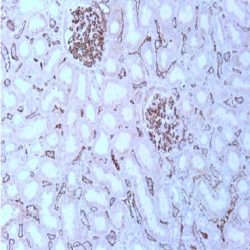
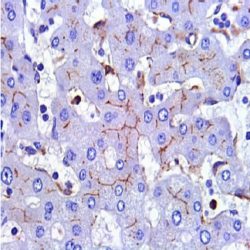
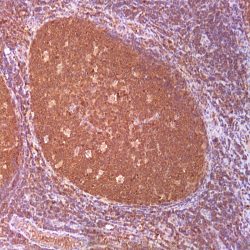
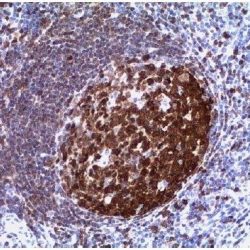
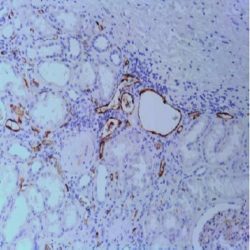
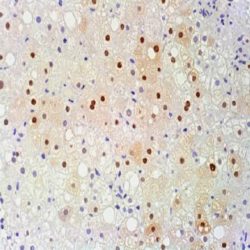
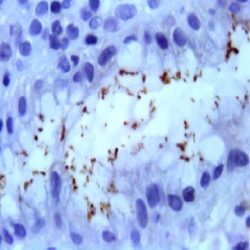
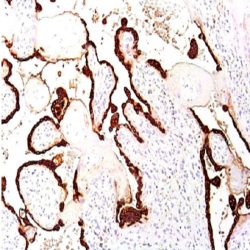
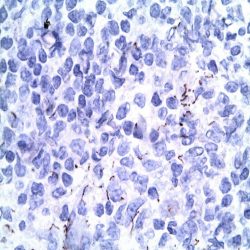
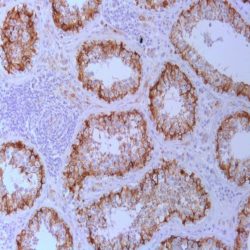
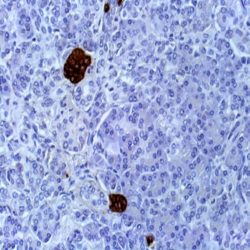
![Chemokine [C-X-C Motif] Ligand 13 (CXCL13) Polyclonal Antibody](https://samatashkhis.com/wp-content/uploads/2018/08/Chemokine-C-X-C-Motif-Ligand-13-CXCL13-Polyclonal-Antibody-2-250x250.jpg)
